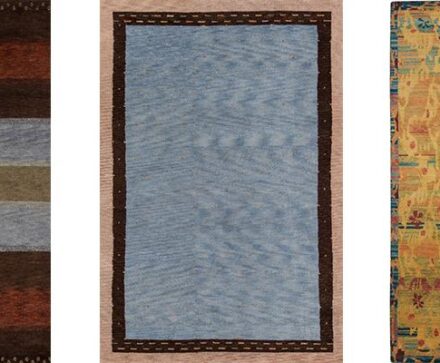Rug Quality vs Value: What to Know
Deciding between rug quality and value can be challenging. Fortunately, you don’t have to pick one or the other. Follow the great tips in the podcast below to shop for good quality rugs at a great price.
John Maher: Hi, I’m John Maher. I’m here today with Sam Presnell, owner of The Rug Gallery, an oriental rug company and carpet store in Cincinnati, Ohio. Today, we’re talking about rug quality versus value. Welcome Sam.
Sam Presnell: Thank you John.
Differences in Rug Pricing
John: Sam, I see prices all over the place for rugs, and for similar rugs like shags. What’s the difference?
Sam: The difference can be as simple as just the materials used. There’s lots of different types of fibers you can use in a rug or carpet. Depending on how the [manufacturer] twisted the fibers or what they blended [the fibers] with, or how they don’t spin it as tight, can make a big difference in the quality and performance of a fiber. Of course, the tighter the density, the denser the product, the more there is to wear, the better it’s going to perform normally.
Are Handmade Rugs “The Best?”
John: Is handmade always a better choice when determining the differences in quality?
Sam: Unfortunately, not today. That is something that everybody believes, I think. It is a myth and it has changed a lot. Handmade can mean several things. Is it hand tufted, or is it hand knotted? When you look at those two products, people probably don’t know the difference. Hand tufted, when you look at the back of the rug, you’re going to see that distinctive cloth covering the back of the rug, or else some type of netting or mesh with a gluey looking back showing through it, and that’s what we call handmade, but it really is not hand knotted. We look at a hand‑knotted rug, you look at the back of the rug, it pretty much looks the same way, except that it is flat on the back, as the design on the face of the rug. You’ve got two different products there, and then, it depends on the fiber you use and how good that fiber is. Everybody thinks that all wool is wool. That’s the farthest thing from the truth. There’s good wool and there’s bad wool, just like people. There’s all kinds of things out there that make a good quality wool, and one would be less quality wool, and the performance that’s going to happen with it. I think the problem is when you see a less expensive rug, in most cases, they’re doing things to make it less expensive. It seems like a deal, it looks great from a picture, or when you see it, but it’s not going to perform. They’ll be cutting corners. They’re going to be cutting the latex that holds the backing together. They’re going to use lesser quality wools. They’re going to use less quality dye stuffs. They’re not going to put as many colors into it. There’s lots of things that make up the quality of a rug.
How to Spot Rug Quality
John: Where does that leave people when they’re trying to pick a rug for their home? I don’t know all of that information and how to determine whether that’s a good quality wool or a not‑good quality wool, or that sort of thing. Is that the kind of thing that I really need to talk to somebody like you and you can walk me through that?
Sam: I would say, definitely. In today’s world that’s very difficult because of online shopping. This has become a commodity that everybody thinks every rug’s the same and that every wool rug’s the same or whatever. I think it’s very, very tough to determine how something’s going to perform. Usually, the information online is very limited, that they’re going to tell you [whether] it’s a rug not made for performance or a rug that is made for performance. They’re just going to tell you it’s made of wool. That’s left up to you to figure out if it’s good or bad. The price sometimes reflects that, and sometimes it does not. It’s very, very challenging for somebody. Definitely, when you go to a specialty store like The Rug Gallery or many stores across the world, you have somebody there who is experienced and who knows the differences. In most cases, they’ve seen rugs go bad. They’ve had rugs come back. They’ve cleaned rugs or repaired rugs. They know what happens in performance. I’ve got a slanted bias opinion there being a specialty rug player, that a consumer should at least call us, talk to us, or shop with us before they make that decision. I think that once they start understanding some of the nuances of quality, it would be very important when they do try to select something.
Rug Quality & Stitch Count
John: One of the things that I’ve heard about with rugs is the knot or stitch count. Does that make a difference in rug quality?
Sam: Again, I would say in most cases, yes, but it’s not in every case. If you use a very crummy wool or something that’s not going to perform fiber‑wise, if this goes for something like that, it doesn’t matter if you rug is 1,000 knots per square inch. It’s not going to perform, just because the fiber is not really designed to perform. You can do different things with stitch counts or knot counts. By performance of the product or the materials you put into it can affect that, as well. It’s not an end‑all‑be‑all. It’s not like a 600‑count, the Egyptian cotton sheets or something you may buy, because there are all different kind of qualities, as well. You may think they’re all the same, but they’re not.
Rug Materials
John: You mentioned viscose rugs. What should we expect in terms of the performance of a rug that’s made with viscose, wool, polyprope, or polyester?
Sam: It’s difficult to say this, but I’m just not a promoter of viscose‑use in any rug. It’s very, very popular. We sell a lot of it. We try to be honest about it, which means we try to let you know what to expect out of it. I don’t believe it’s made for high performance. It’s really a product that’s made from many materials. It can be bamboo. It can be made from synthetic fibers, from oil byproducts, as well. Most of it’s from natural fibers like bamboo, and then, they basically make it like they make paper. They put it into pulp, and they extrude it into the fiber. I have to say that this stuff looks fantastic, John. You would love this rug. When you see it brand new, it’s so shiny. It looks better than silk in a rug. When it’s brand new, it just screams “buy me.” You just can’t help but like it, but it’s not going to perform. I think a lot of people were very disappointed, and I always hear those three words ‑‑ “Had I known.” When I hear that, I know that somebody’s going to tell me that they’re very unhappy and say “If you had told me that, I would never have bought it.”
John: Right. “Had I known that that was only going to last a few years or something like that, I never would have done that.”
Sam: Then when you go to clean it, there’s all kinds of issues with cleaning. I’d say, 99% of the cleaners out there can’t clean it, and then, you’re going to blame it on the cleaner. It wasn’t the product, it was the guy who cleaned it for you. Basically, viscose is not meant to be cleaned. You can imagine. You take a paper. You get it, and you can read it. If you poured water on that paper, it all just clumps together when it gets wet. That’s what happens with viscose or any type of art silk, or whatever you want to call it, faux silk, or whatever you want to call viscose. It’s all going to do that when it gets wet. It’s going to absorb, so it’s very stainable. It’s very soft, so it’s going to flat and mat. When it comes back to you after a cleaning, you’re going to swear the guy gave you a different rug. It’s very alarming to me, but it’s also very popular. To me, it’s like sour grapes. I complain about it. I want to be honest with you, but at the same time, there’s nothing out there that really looks like that unless you buy silk. Silk is very expensive. If you say, “Well, gee whiz. I’m going to spend $300 on a rug. Viscose is a fantastic‑looking rug. If I had to buy that in silk, it’d probably be $2,000.” It isn’t to the same consumer price‑point‑wise, but it looks like it.
John: What about wool?
Sam: Wool is definitely in my opinion the best, but as I said, the caveat is that not all wools are created equal. There’s short staple. There’s long staple. Of course, long staple is better, which remember, wool is sheep hair. Basically, the length of that fiber, how the condition of that sheep is, how often they shear it, the climate that it comes from, its diet can play into performance of the rug and the quality of the wool. If you buy a short‑staple wool that’s not of high quality and it’s full of short fibers put together, it’s going to fuzz and shed like a bear. You’re going to say, “Gee whiz. Had I known.” The best way to really test that though on wool is just scrub it with your hand. If you’re lucky enough to be in a shop where you can actually test it, you can actually rub it with your fingertips. The wool will basically break down. If it comes with a lot of shedding, you’ve got a rug that’s not going to perform. It’s going to shed like a bear. You’re going to be very unhappy, whereas, if you’ll get a little bit of shedding and it’s slight and you can’t tell, that’s a real high‑quality wool. It’s probably going to perform.
John: That’s a really good tip. What about polyprope? What is that?
Sam: Polyprope basically is an oil byproduct that is fibered, like a plastic in so many ways. One thing nice about polypropylene is it’s unsustainable, it’s a great product. They use a lot of it commercially. We use a lot in machine‑made rugs. We don’t use so much in hand‑made rugs today. Most of your outdoor products are made from polypropylene. Because it’s an oil‑based or a synthetic fiber, it’s inert. It doesn’t absorb, it’s not going to be able to get any moisture to it. If you spill something on it, you just wipe it off. It’s really fantastic for that. The problem with polypropylene is long‑term how it looks with wear. Eventually, I equate it to if you took a piece of sandpaper to a clear piece of glass and you start rubbing on it. Eventually, you would dull that clear piece of glass. You wouldn’t be able to see through it. It would become what they call “low peg,” where you just see shadows. That’s what happens with synthetic rugs from polypropylene. You, eventually, get what I call gray or dull. You’ll send it out to be cleaned, and the traffic area will be dull‑looking. Then, it comes back from the cleaners and you say, “You know what? They didn’t clean the rug very well.” You can rub a white glove or a cloth over that area you think didn’t get cleaned properly. You’re not going to find any dirt there, but what you’re going to see is what we call the “grain of the yarn,” where the product just becomes very frosted, dull, and not as nice and bright as the areas that didn’t get wear.
John: It’s not that there’s dirt on it that can get cleaned off. It’s just changing color and fading on its own.
Sam: Exactly. It isn’t what I call fading. It’s just dulling a grain because you’re taking that sandpaper with your feet. All the dirt and grit is doing that to the fiber. It’s taking that nice, clear, smooth fiber and dulling it and scuffing it.
John: Then finally, what about polyester?
Sam: Polyester is a lot like polypropylene. It’s, again, an oil‑based product that a lot of times has a lot of different other things with it. A lot of the same characteristics, good stain resistance. Certain colors it just doesn’t take to, red being one of them. You won’t see as much color choices in polyester. Polyester is all over the board, too, as far as quality depending on how they spin it, how tightly they weave it. Some of it will flatten very quickly if it’s not spun tightly and a good density applied to it. You might call it matting or crushing. We just call it pile direction.
John: That’s really great information, Sam. I appreciate you speaking with me today.
Sam: You’re welcome, John.
John: For more information about oriental rugs and carpets, visit ruggallerycincy.com, or call 513‑793‑9505.


